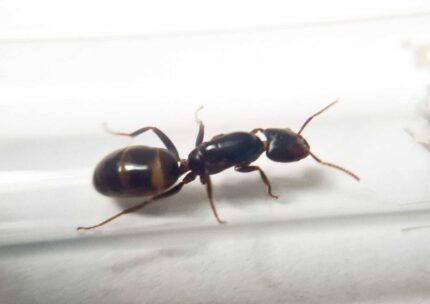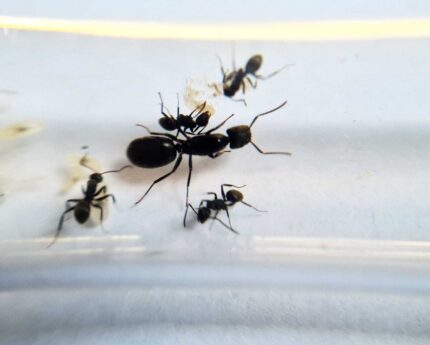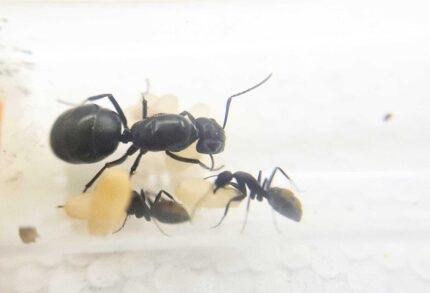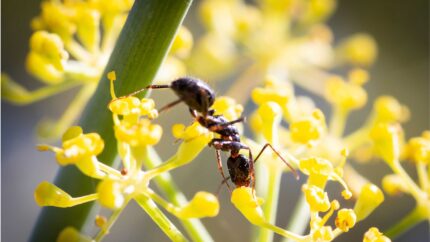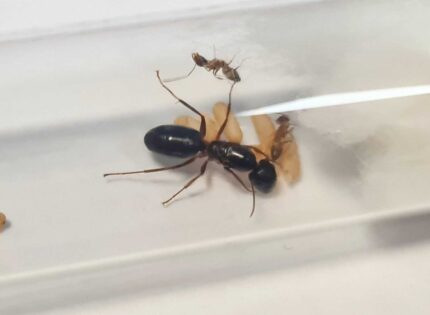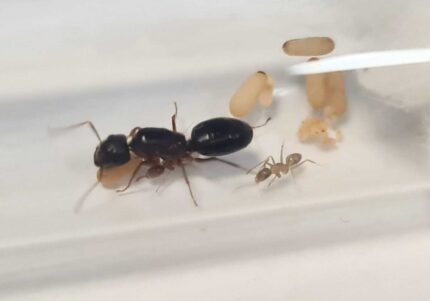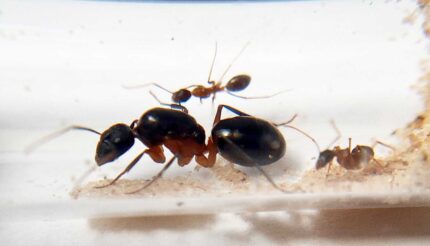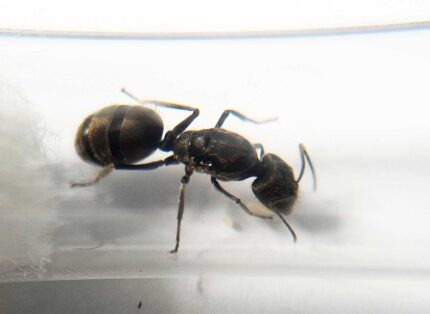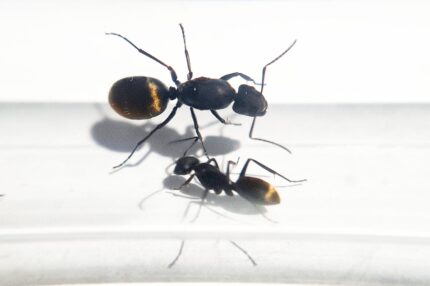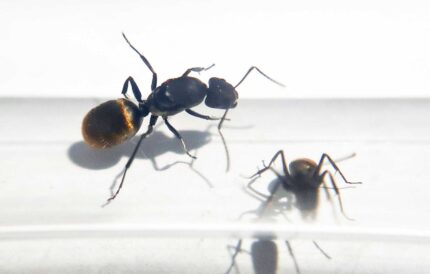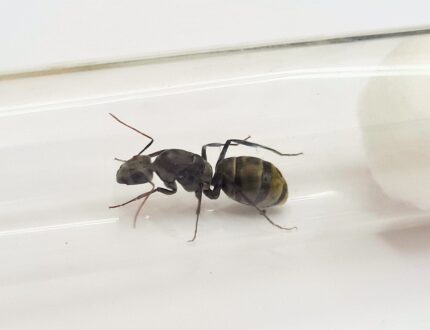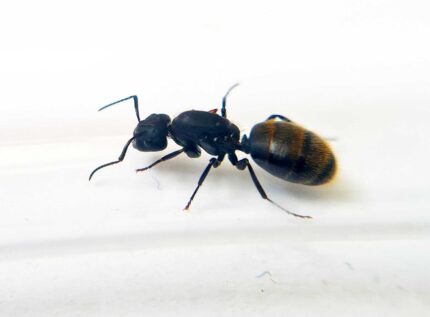Camponotus Abscisus
Camponotus abscisus ist eine Ameisenart mit monogynem Kolonietyp und schneller Entwicklungsgeschwindigkeit. Die Königin misst 9-11 mm, Arbeiter reichen von 3,5-5,5 mm und Majors sind 5-6,5 mm groß. Sie haben eine schwarz-braune Färbung, und ihre Ernährung besteht aus Insektenfutter, Sirup, Früchten, Gemüse, Gelee und gekochtem Huhn ohne Salz.
Camponotus abscisus
259,90 zł – 359,90 złCamponotus abscisus is a species of ant with a monogynous colony type and a fast development speed. The queen measures 9-11mm, workers range from 3.5-5.5mm, and majors are 5-6.5mm in size. They have a black-brown coloration and their nutrition consists of insect food, syrup, fruits, vegetables, jelly, and cooked chicken without salt.
Camponotus Aeneopilosus
Camponotus aeneopilosus ist eine monogynische Ameisenart mit Kolonien von bis zu 5000 Arbeitern. Sie entwickeln sich schnell und haben einen Größenbereich von 14-16 mm für Königinnen, 6-9 mm für Arbeiter und 8-12 mm für Major-Arbeiter. Diese schwarzen Ameisen benötigen eine Ernährung aus Nahrungsinsekten, Sirup, Früchten, Gemüse, Gelee und gekochtem Huhn ohne Salz.
Camponotus Aethiops
Camponotus aethiops ist eine monogynische Ameisenart mit einer Koloniegröße von bis zu 1000 Arbeitern. Die Entwicklungsgeschwindigkeit ist mittel. Die Königin misst 12-13 mm, Arbeiter 4-7 mm und Majors 8-10 mm. Sie sind schwarz gefärbt mit leicht roten Beinen und Unterleib. Ihre Ernährung umfasst Nahrungsinsekten, Sirup, Früchte, Gemüse, Gelee und gekochtes Essen.
Camponotus aethiops
79,90 zł – 209,90 złCamponotus aethiops is a monogynous ant species with a colony size of up to 1000 workers. The development rate is medium. The queen measures 12-13mm, workers measure 4-7mm, and majors measure 8-10mm. They are black in color with slightly red legs and bottom. Their nutrition includes food insects, syrup, fruits, vegetables, jelly, and cooked food.
Camponotus Albosparsus
Camponotus albosparsus ist eine monogynische Ameisenart mit einer Koloniegröße von bis zu 1000 Arbeitern. Sie haben eine schnelle Entwicklungsgeschwindigkeit. Die Königin misst 12-13 mm, während Arbeiter 4-6 mm und Majors 8-10 mm messen. Ihre Farbe ist eine Kombination aus braunen Beinen und einem gelblich-braunen Brustkorb. Sie konsumieren Nahrungsinsekten, Sirup, Früchte, Gemüse und Gelee.
Camponotus albosparsus
139,90 zł – 289,90 złCamponotus albosparsus is a monogynous ant species with colony size up to 1000 workers. They have a fast development speed. The queen measures 12-13mm while workers are 4-6mm and majors are 8-10mm. Their color is a combination of brown legs and a yellowish brown chest. They consume food insects, syrup, fruits, vegetables, and jelly.
Camponotus Arnoldinus
Camponotus arnoldinus ist eine Ameisenart mit monogynem Kolonietyp und kann eine Koloniegröße von bis zu 5000 Arbeitern haben. Sie haben eine schnelle Entwicklungsgeschwindigkeit und kommen in verschiedenen Größen und Farben. Ihre Ernährung besteht aus Nahrungsinsekten, Sirup, Früchten und Gemüse.
Camponotus arnoldinus
329,90 zł – 489,90 złCamponotus arnoldinus is a species of ant that has a monogyny colony type and can have a colony size of up to 5000 workers. They have a fast development speed and come in various sizes and colors. Their nutrition consists of food insects, syrup, fruit, and vegetables.
Camponotus Auriventris
Camponotus auriventris ist eine monogynische Ameisenart mit Kolonien, die bis zu 5000 Arbeiter enthalten können. Sie haben eine mittlere Entwicklungsgeschwindigkeit und kommen in verschiedenen Größen: Königinnen messen 13-17 mm, Arbeiter 4-9 mm und Majors 9-12 mm. Diese Ameisen haben eine graue Farbe mit einem goldenen Schimmer, und ihre Ernährung besteht aus Nahrungsinsekten, Sirup, Früchten, Gemüse, Gelee und gekochtem Huhn.
Camponotus auriventris
209,90 zł – 349,90 złCamponotus auriventris is a monogynous ant species with colonies that can contain up to 5000 workers. They have a medium development rate and come in different sizes: queens measuring 13-17 mm, workers measuring 4-9 mm, and majors measuring 9-12 mm. These ants have a gray color with a golden sheen and their nutrition consists of food insects, syrup, fruit, vegetables, jelly, and cooked chick.
Camponotus Baldaccii
Camponotus baldaccii ist eine monogynische Ameisenart mit Kolonien von bis zu 5.000 Arbeitern. Sie haben eine mittlere Entwicklungsgeschwindigkeit, und die Königin misst 14-17 mm, Arbeiter 6-11 mm und Majors 11-13 mm. Sie sind braun-orange gefärbt, und ihre Ernährung besteht aus Nahrungsinsekten, Sirup, Früchten, Gemüse, Gelee und gekochtem Huhn.
Camponotus baldaccii
289,90 zł – 479,90 złCamponotus baldaccii is a monogynous ant species with colony sizes of up to 5,000 workers. They have a medium development rate and the queen measures 14-17mm, workers 6-11mm, and majors 11-13mm. They are brown-orange in color and their nutrition consists of food insects, syrup, fruits, vegetables, jelly, and cooked chicken.
Camponotus Chilensis
Camponotus chilensis – Süße Ameise mit goldenem Rücken
Camponotus chilensis
499,90 zł – 659,90 złСаmponotus chilensis – Cute Golden back ant
Camponotus Cinctellus
Diese Überraschungsbox enthält mindestens eine Ameisenkolonie, ein Formicarium und verschiedene andere Artikel. Seien Sie versichert, dass diese Box Ihre Erwartungen übertreffen wird.
Camponotus cinctellus
209,90 zł – 299,90 złThe Camponotus cinctellus ant colony is monogynous and can have up to 10,000 individuals. They have a medium development rate. The ants vary in size, with queens measuring 15-17 mm, workers measuring 6-10 mm, and majors measuring 13-15 mm. They have a matte black head and chest, and their gastres have strong hair with golden reflections. Their nutrition consists of food insects such as cockroaches and crickets, as well as syrup made from water and honey.
Camponotus Darwinii
Camponotus darwinii ist eine monogynische Ameisenkolonie mit einer Größe von 3000 bis 5000 Arbeitern. Sie haben eine schnelle Entwicklungsgeschwindigkeit, und ihre Königin misst 12-14 mm, während Arbeiter 5,5-8 mm und Major-Ameisen 9-11 mm messen. Sie sind schwarz mit goldenen Haaren, die ihren Körper bedecken. Ihre Ernährung besteht aus Insektenfutter, Sirup, Früchten, Gemüse und Gelee.


